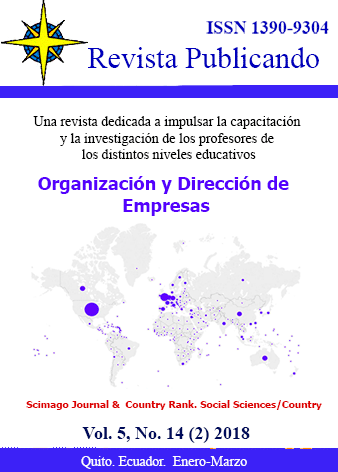Resumen
The present research delved into the correlation of spirituality in workplace and people”™s attitude towards the virtual world mediated by the organizational citizenship behavior. Due to the extended meaning of the spirituality concept, Liu and Robertson”™s(2011) three-factor scale, Podsakoff”™s (2000) questionnaire for measuring citizenship behavior and Kim et al.”™s (2005) seven-factor virtual worldquestionnaire were used. The present research population was comprised of 342 managers of private companies all over Iran. To analyze the data, firstly the reliability was assessed through Cronbach”™s alpha and then the required statistical analyses were run to estimate the correlation coefficients. The findings revealed a statistically significant causal relationship between spirituality in organizational environment and attitude towards virtual world mediated by citizenship behavior.
Referencias
Bienstock, C. Carol and Demoranville, W. carol and Smith, K. Rachel, (2003),"Organizational citizenship behavior and service quality", Journal of services marketing, vol. 17, No. 4, pp. 357-378.
Boje, D. (2000) "Another view: approaches to the study of spiritual capitalism", in Biberman, J. and Whitty, M. (Eds), Work & Spirit, The University of Scranton, Scranton, PA, pp. xxv-xxxii.
Bolino, M. C., and Turnley, W. H. )2003(. Going the extra mile:Cultivating and managing employee citizenship behavior.Academy of Management Executive. Vol.17 No.3 pp.60–71.
Borg, W.R. and Gall M.D. (1989). Educational Research: An introduction (5th ed.). New York: Long man.
Borman, W. C. & Motowidlo, S. J. (1997). Task performance and contextual performance: The meaning for personnel selection research, Human Performance, vol.10, No.5, pp. 99-109.
Castro, Carmen. B, and Armario, Enrique and Ruiz, David's, (2004), "The influence of employee organizational citizenship behavior on customer loyalty", international journal of service industry management, vol.15, No. 1, pp. 276-282.
Chen, Chin-Yi & Yang, Chin-Fang (2011). The Impact of Spiritual Leadership on Organizational Citizenship Behavior: A Multi-Sample Analysis, Journal of Business Ethics, Springer Science and Business Media B.V.
Graber, D.r. (2001) "Spirituality and healthcare organizations", Journal of Healthcare Management, vol.46, No.1, pp.39-50.
Gunasekaran A., Ngai E.W.T., (2005). E-commerce in Hong-kongian empirical perspective and analysis, Internet Research. Vol.15, No.2, pp.141-159.
Harmer, Richard (2006). "Organisational citizenship behaviour, emotional intelligence and spirituality: What”™s the relationship?", Australian Catholic University, St Patrick”™s Campus, Victoria, Fitzroy VICTORIA 3065 Australia
Helminiak, D. A. (1998). Religion and the human sciences: An approach via spirituality. Albany: State University of New York
Helminiak, D. A. (2006). The role of spirituality in formulating a theory of the psychology of religion. Zygon, 41, 197-224.
Hyman, C., & Handal, P. J. (2006). Definitions and evaluation of religion and spirituality items by religious professionals: A pilot study. Journal of Religion and Health, 45, 264-282.
Kim yong beom, Lee Zoonky and Gosain Sanjay, (2005). Important to successful ERP implementation process, Business Process Management Journal, Vol.11, No:2, pp158-170.
Koenig, H. G., McCullough, M. E., & Larson, D. B. (2001). Handbook of religion and health. New York: Oxford University Press.
Krishnakumar, S. and Neck, C.P. (2002) "Th "what", "why" and "how" of spirituality in the workplace", Journal of Managerial Psychology, Vol.17, No.3, pp.153-164.
Liu, C. H. and Robertson, P. J. (2011). Spirituality in the Workplace: Theory and Measurement, Journal of Management Inquiry 2011 20: 35 originally published online 26 July 2010, 20(1) pp. 35–50.
Lund Dean, k., Fornaciari, C.J. and McGee, J.J. (2003) "Research in spirituality, religion, and work", Journal of Organizational Change Management, Vol.16, No.4, pp.378-395.
MacDonald, D. A. (2000). Spirituality: Description, measurement, and relation to the five factor model of personality. Journal of Personality, 68, 153-197.
McMillan, J. H., Schumacher, S., (1984).Research in education: A conceptual introduction. Boston: Little Brown and Company.
Mitroff, I. and Denton, E. (1999) "A Spiritual Audit of Corporate America: A Hard Look at Spirituality", Religion, and Values in the Workplace. Josses-Bass, San Francisco, CA.
Naylor, T.H., Willimon, W.H. and Osterberg, R. (1996). "The search for meaning in the workplace", Abington Press, Nashville, TN.
Neal, J. and Biberman, J. (2003) "Introduction: The Leading Edge in Research on Spirituality and Organizations", Journal of organizational change management, vol.16, No.4, pp363-366.
Podsakoff, P.M., MacKenzie, S.B., Paine, J.B. and Bachrach, D.G. (2000). Organizational citizenship behaviors: ACritical Review of the Theoretical andEmpirical Literature and Suggestions forFuture Research, Journal of Management. Vol.26, No. X 51, pp. 1-56.
Organ, D.W, (1988),"Organizational citizenship behavior the good soldier syndrome", Lexington book, Lexington, MA.
Shellenbarger, S. (2000) "More Relaxed Boomers, Fewer Workplace frills and other Job Trends", wall street journal, december27, p.B-1.
Wiersma, William (1991). Research Methods in Education: An Introduction (5th ed.) Boston. USA.: Allynaand Bacon.
Usted es libre de:
Compartir — copiar y redistribuir el material en cualquier medio o formato
Adaptar — remezclar, transformar y construir a partir del material
La licenciante no puede revocar estas libertades en tanto usted siga los términos de la licencia
Bajo los siguientes términos:
Atribución — Usted debe dar crédito de manera adecuada, brindar un enlace a la licencia, e indicar si se han realizado cambios. Puede hacerlo en cualquier forma razonable, pero no de forma tal que sugiera que usted o su uso tienen el apoyo de la licenciante.
NoComercial — Usted no puede hacer uso del material con propósitos comerciales.
CompartirIgual — Si remezcla, transforma o crea a partir del material, debe distribuir su contribución bajo la lamisma licencia del original.
